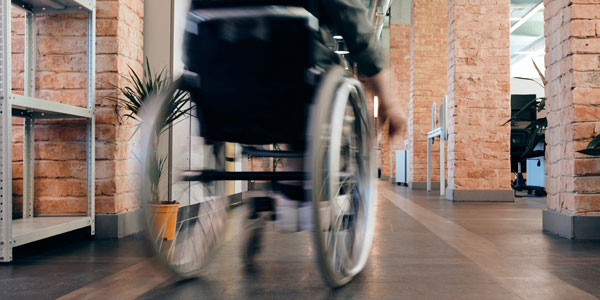
The energy it takes to navigate an abled-bodied world
- Marcia Zali
The implementation of universal design and access could improve the lives of people living with disabilities.
In its preamble, the United Nations Convention on the Rights of Persons with Disabilities recognises the need to promote and protect the human rights of all people with disabilities, and for the international community to cooperate to improve the lives of persons with disabilities globally, particularly in developing countries. In South Africa, universal design and access will improve the lives of the 20% of the population living with disabilities.
Since 1986, the Wits Disability Rights Unit (DRU) has been working to overcome the educational and accessibility barriers facing students with visual, hearing, physical, learning, and psychological disabilities, and chronic illnesses.
“Universal access means providing access to services for all people, to the greatest extent possible, without the need for adaptation or specialised design. Universal design is the design of buildings, products, or environments to make them accessible to most people, regardless of age, disability, background, or any other factors,” says Head of the DRU, Dr Anlia Pretorius.


Everyday life demands much energy
With the world generally designed to meet the needs of ‘able-bodied’ people, everyday activities such as communicating, accessing buildings and public transport, reading and writing, require a lot more energy and effort by people with disabilities than ‘able-bodied’ people. However, Subhashini Ellan, the Academic and Facilities Access Coordinator at DRU, says the amount of energy required by people with disabilities to execute tasks is not easy to quantify.
“The energy expended by people with disabilities is difficult to quantify because of the variances in the types of disabilities and impairments, a person's body strength and abilities, as well as the accessibility of the spaces and built environment encountered,” explains Ellan.
“Wheelchair users may need to take longer routes to access buildings, often with no clear directions or accessible lifts or ramp access. This may cause additional fatigue leading to reduced functioning after exertion. Blind people require reading material to be converted to an accessible format, software screen readers or braille print and this may take more time and energy to read due to the various complexities of the formats,” adds Andrew Sam, the Adaptive Technologist at the DRU.
Audiologist and Senior Lecturer in the Wits Department of Speech Pathology and Audiology, Dr Victor de Andrade says that basic communication requires a lot of energy for people with communication impairments such as hearing loss, deafness, and hearing impairment.
In an ongoing study into how Deaf people access healthcare at hospitals, de Andrade says that the research reveals that a lot of energy in the form of planning and preparation is required for Deaf people to access healthcare.
“Going to a doctor’s appointment requires a lot of energy in terms of getting somebody to go with them to serve as an interpreter or as an extra set of ears, because they may not be able to hear everything that the doctor communicates to them,” he says.
The effort and difficulty to communicate also affects the families of people with hearing loss, deafness, and hearing impairment. Family members, too, have to use a lot of their time and energy to make the lives of their loved ones less strenuous as they try to manoeuvre in an ‘able-bodied’ world.

Enabling resources exist
The good news is that the technology and research in to finding ways to improve the quality of life for people with disabilities has become more advanced, reducing the amount of energy and effort it takes to function.
Assistive devices such as hearing aids, cochlear implants, FM systems (special wireless systems that help people hear better in a noisy environment), and DM systems, which use digital signals to transmit sound from a microphone (speaker) to the receiver (individual with hearing loss), are some of the tools that can be used to improve communication and hearing for people with hearing impairment or loss.
“If somebody has had a stroke, there may be opportunities for speech-language therapy, as well as redirected communicative energy in the form of alternative and augmentative communication technology. If somebody cannot talk, there are alternative ways of communicating, but even that requires energy,” says de Andrade.
Resources at the DRU include accessible study material for students with visual and print impairment (the difficulty or inability to read printed material due to a perceptual, physical or visual disability), human support through sign language interpreting, real-time captioning for Deaf and hearing-impaired students, as well as the provision of computer centres equipped with state-of-the-art assistive technologies.
“DRU staff are specialists in their field and provide advanced technological and psychosocial support and training to students. We have pushed for the use of accessible learning environments such as ulwazi [the Wits Learning Management System] to ensure that students with various disabilities are supported, Universal Design for Learning resources for academics, ramps, handrails and tactile paving, disabled access online maps and signage, and disability-accessible parking spaces,” says Pretorius.
In addition, the Wits transport service has made available two buses that can accommodate wheelchair users. Students with disabilities are also accommodated as close as possible to where their lectures take place. Those who need extra time and other concessions are assisted with screening assessments and motivations to their faculties to grant the necessary concessions.
- Marcia Zali is a freelance writer.
- This article first appeared in Curiosity, a research magazine produced by Wits Communications and the Office of the Deputy Vice-Chancellor: Research and Innovation.
- Read more in the 15th issue, themed: #Energy. We explore energy research into finding solutions for SA's energy crisis, illuminate energy needs of people with disabilities, address the energy and digital divide in an unequal society, and investigate the origins of fire control.

